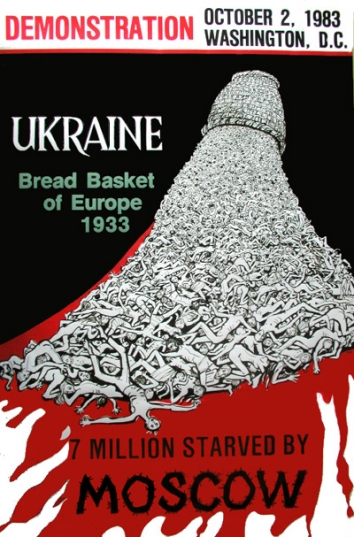Featured Galleries USUBC COLLECTION OF OVER 160 UKRAINE HISTORIC NEWS PHOTOGRAPHS 1918-1997
 Holodomor Posters
Holodomor Posters

Consumption a panacea to weak world outlook in rapid-growth markets
 Ernst & Young LLC, Kyiv, Ukraine
Ernst & Young LLC, Kyiv, Ukraine
23 April, 2012
23 April 2012 – While the global economy is still in an uncertain state and trade flows remain subdued, rapid-growth markets (RGMs) around the world are proving resilient. RGMs are expected to grow collectively at 5.3% this year, bouncing back to 6.3 % in 2013, according to Ernst & Young’s quarterly Rapid Growth Markets Forecast (RGMF).
Despite the decline in financial wealth in H2 2011 in many markets, demographic trends and rising real incomes over the medium term are set to underpin strong consumption. Moreover, consumption and retail sales have been robust in many RGMs in recent months – notably in Mexico, Brazil, Indonesia and China.
An unexpected, strong pickup in activity towards the end of last year and beginning of this year in some RGMs means they will contribute over one-half of global growth over the next three years.
Rain Newton-Smith, Senior Economic Adviser to Ernst & Young’s Rapid Growth Markets Forecast explains, “RGMs are proving resilient in the face of the twin impacts of the Eurozone recession and continued tensions in the Middle East. Although not all RGMs are enjoying equally solid growth prospects, they are still offering good opportunities to companies and investors across a wide range of sectors.”
Alexis Karklins-Marchay, co-Leader of the Emerging Markets Center at Ernst & Young comments, “Despite a dip in growth this year, the outlook for RGMs in the medium term is optimistic. New trends such as regional specialization, a huge expansion of the middle-class and the increase in trade between RGMs, will serve as significant catalysts to growth and, in turn, be hugely beneficial for companies that invest in these markets.”
Consumption reliable engine of growth
The increase in the middle class in RGMs, particularly in Asia, will drive growth in consumer demand and trade flows between RGMs. For instance, the number of households in China with a real disposable income of US$30,000 to US$50,000 will increase from 1.6 million in 2010 to an estimated 26 million in 2020.
Consumption in most RGMs will continue to outpace the advanced economies. According to the forecast, consumption growth in the RGMs is expected to be more than twice as fast as in the US, with consumption growth in China four times as fast.
Eurozone weakness will weigh on RGM growth
The continued uncertainty in the Eurozone not only affected European RGMs but also those with trade and financial links to the region. For example, the weaker outlook is affecting African RGMs such as South Africa, Egypt and Ghana where a third of exports are destined for the Eurozone. Increased volatility in financial markets from a renewed escalation of the crisis in the Eurozone will have a significant impact on growth in countries as diverse as South Africa, Hong Kong and Chile where capital markets are an important driver of growth.
The combination of the recession and new rules on capital requirements has led to the major European banks behaving much more cautiously, including the reduction of external funding of their substantial operations in emerging Europe. This could further squeeze credit supply in the region – already under pressure from the deterioration in economic prospects.
In July to November 2011, banks pulled out €4.8b from Poland, in contrast with the heavy inflows they made in the first six months of the year and during 2010. A potential squeeze on credit by European banks would also have an impact on RGMs further afield, with a significant presence by European banks in countries such as Chile, Turkey, Mexico, Egypt and Brazil.
Divergence in FDI
Foreign direct investment (FDI) flows to some of the larger RGMs, such as Brazil, Russia and China, have held up reasonably well but those to emerging Europe and countries in the Middle East, such as Egypt, have weakened substantially. Portfolio inflows to RGMs, did, however, weaken significantly in the second half of last year.
While we have seen some recoveries in equity prices in RGM companies in recent weeks, and also in some local currency bond markets, share prices for many RGM companies are still well below the levels seen at the start of last year. Similarly, share prices for companies in European RGMs and Egypt have been the worst performers over the past year, affecting consumer wealth and the ability of firms to invest.
Inflation to fall this year
The positive mood among global investors at the start of 2012, aided by abundant liquidity in the developed economies, has led to significant rallies in many of the RGMs and currencies that had slumped during the last few months of 2011. If this trend persists, it should support business confidence and help to dampen inflation (though commodity prices have also picked up again).
Inflation has eased for most RGMs from the peaks toward the middle of last year, as the impact of high oil and commodity prices has waned. The global slowdown has also led to more subdued inflationary pressure coupled with the impact of credit tightening from earlier interest rate rises. RGMF expects inflation in RGMs as a whole to moderate from close to 6% last year to 4.8% this year.
Overall, some RGMs are still battling with rising inflation, notably Turkey, Nigeria and Argentina, while inflation in India Vietnam and Egypt is still uncomfortably high, limiting their scope to cut interest rates or provide a boost through government spending.
Volatility of oil and commodity prices to impact RGMs
Prices are likely to remain volatile in 2012. Heightened geopolitical tensions raise continued supply concerns, while the ongoing Eurozone debt crisis weighs on oil demand prospects. The tightness of supply will also make the market more vulnerable to further surprises, making spikes in oil prices likely.
This has implications for RGMs, particularly the large oil importers such as India and China. In India’s case, it has the potential to further dent growth significantly, as the central bank is only now signaling a hold in policy tightening after tackling the last bout of inflation. Other RGMs, such as Nigeria, Ghana, Saudi Arabia and Qatar, will see a boost to their growth prospects through higher oil prices improving export revenues and their fiscal balances.
RGMF expects oil prices to average US$112 per barrel in 2012, with the price falling from its current highs toward US$105 by the end of the year assuming geopolitical tensions subside; supply from the Organization of the Petroleum Exporting Countries (OPEC) increases; and, global demand remains subdued in the near term. Over the course of 2013, oil prices will start to rise again in nominal terms reaching an average of US$135 per barrel in 2020.
Ukraine: External funding constraints may curb growth in the near term
Growth prospects for 2012 have deteriorated further as debt problems have worsened in the Eurozone and as Russia has attached strong conditions to gas import price cuts. We now expect growth of 3.1% in 2012, down from 5.1% in 2011 and the risks are on the downside, as stalling Eurozone growth dampens export prospects (exports contribute over 50% of GDP and more than one-quarter of exports go to the EU).
Further ahead, growth is forecast to recover to close to 5% in 2013 and then to about 6% p.a. in 2014 and 2015, as the outlook for gas exports improves and recovering European demand boosts exports and capital flows.
Rising energy costs and weakening export markets widened the current account deficit sharply to 6% of GDP in 2011. But external financing remains difficult with IMF funding still suspended — the IMF continues to demand a reduction in household energy subsidies that cannot be delivered until gas import costs are reduced. Moreover, the 2012 budget deficit is likely to stay above the official target of 2.5% of GDP because of slower than expected growth. As a result of these strains, inward investment will remain subdued. The external deficit may also pose a risk to the UAH stability that has underpinned a gradual decline in inflation in the last two years.
About the Rapid Growth Markets Forecast
The quarterly Ernst & Young Rapid-Growth Markets Forecast is a macroeconomic forecast co-produced with Oxford Economics. It aims to fulfill the need for practical and accessible economic forecasts and insights on the development of 25 rapid-growth countries around the world. These countries have been selected on three key criteria: they should be large, both in terms of GDP and demographics; they should be dynamic, rapidly growing countries; and should be of strategic importance for business development. Our forecast is based on Oxford Economics’ Global Econometric Model and provides both analysis of the implications for corporations doing business in rapid-growth markets and recommendations for decision-makers. Follow the development by tuning in to our quarterly webcast debate and by visiting www.ey.com/rapidgrowth
About Ernst & Young
Ernst & Young is a global leader in assurance, tax, transaction and advisory services. Worldwide, our 152,000 people are united by our shared values and an unwavering commitment to quality. We make a difference by helping our people, our clients and our wider communities achieve their potential.
Ernst & Young expands its services and resources in accordance with clients’ needs throughout the CIS. 4000 professionals work at 18 offices in Moscow, St. Petersburg, Novosibirsk, Ekaterinburg, Kazan, Krasnodar, Togliatti, Yuzhno-Sakhalinsk, Almaty, Astana, Atyrau, Baku, Kyiv, Donetsk, Tashkent, Tbilisi, Yerevan, and Minsk.
Ernst & Young established its practice in Ukraine in 1991. Ernst & Young Ukraine now employs more than 500 professionals providing a full range of services to a number of multinational corporations and Ukrainian enterprises.
For more information about our organization, please visit www.ey.com/ua.
This news release has been issued by EYGM Limited, a member of the global Ernst & Young organization that also does not provide any services to clients.
UKRAINE
External funding constraints may curb growth in the near term
Growth prospects for 2012 have deteriorated further as debt problems have worsened in the Eurozone and as Russia has attached strong conditions to gas import price cuts. We now expect growth of 3.1% in 2012, down from 5.1% in 2011 and the risks are on the downside, as stalling Eurozone growth dampens export prospects (exports contribute over 50% of GDP and more than one-quarter of exports go to the EU).
Further ahead, growth is forecast to recover to close to 5% in 2013 and then to about 6% p.a. in 2014 and 2015, as the outlook for gas exports improves and recovering European demand boosts exports and capital flows.
Rising energy costs and weakening export markets widened the current account deficit sharply to 6% of GDP in 2011. But external financing remains difficult with IMF funding still suspended — the IMF continues to demand a reduction in household energy subsidies that cannot be delivered until gas import costs are reduced. Moreover, the 2012 budget deficit is likely to stay above the official target of 2.5% of GDP because of slower than expected growth. As a result of these strains, inward investment will remain subdued. The external deficit may also pose a risk to the UAH stability that has underpinned a gradual decline in inflation in the last two years.











